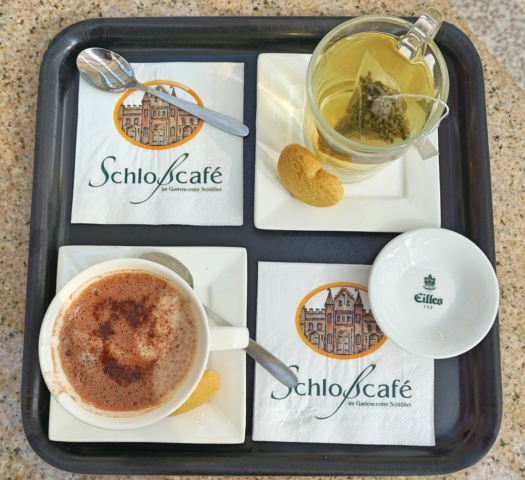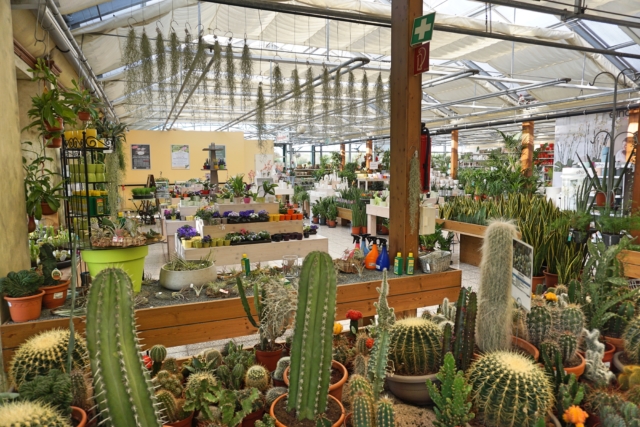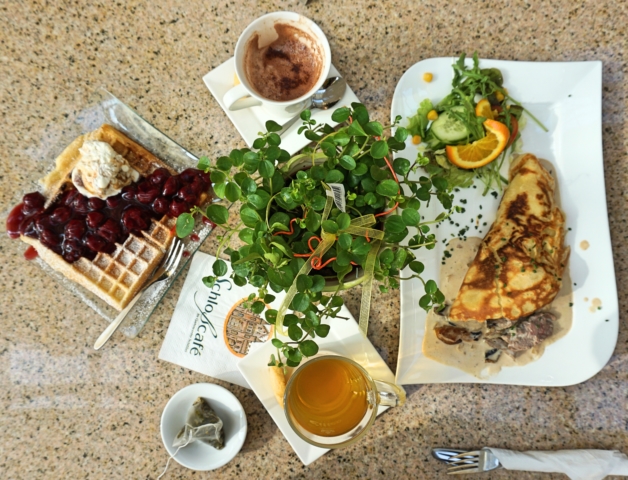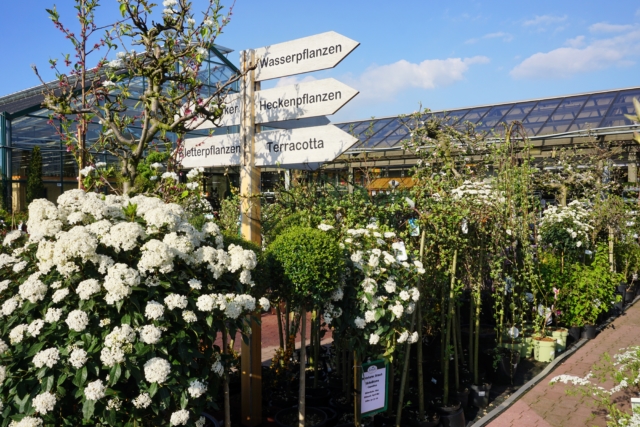Although this is an unlikely spot for a tourist or visitor to ever get to, for you adventurers out there Schloßcafé, a café in a conservatory-like space adjacent to a garden center named Schlößer, at a country road in Moers, Germany, is definitely worth a mention, a write-up even. Personally, I discovered it on a trip to the garden center, which I knew of since my brother lives in the area. But for those of you who think you’re unlikely to venture further afield, if you haven’t had a waffle with hot cherries and cream before, then it’s about time to find out about it.
In the West of Germany, in the state of North Rhine-Westphalia, you can find the Bergisches Land (country of Berg, from the Duke of Berg), a low mountain range region east of the river Rhine, of which Wuppertal is the biggest city. In a landscape of winding rivers and creeks, dense, thick woods, wide-open meadows and sparkling lakes, you will come across a food tradition which has been in existence since at least 200 years ago: The Bergische Kaffeetafel.
It is a food feast which consists of coffee and both savoury and sweet items, such as dark rye (Schwarzbrot – “black bread”) and/or mixed wheat and rye bread (Graubrot – “grey bread”), cheese, ham, sausage, Rosinenstuten (sweet raisin bread), honey, rice pudding with sugar and cinnamon, and the popular Bergische Waffeln – waffles with hot sour cherries and cream or ice cream (as also commonly had today). Unlike the German tradition of Kaffee und Kuchen, where essentially only coffee and cake are served, the Bergische Kaffeetafel custom is a more extravagant and lavish one, emphasizing hospitality and commensality.
The Bergische Kaffeetafel will have developed when drinking coffee became more commonplace even in the countryside. In pre-industrial Europe the colonial sugar, coffee, tea, and cocoa trade led to the development of a coffee house culture in many parts of the continent, with many coffee houses offering an alternative to alcoholic beverages as a way to mingle and socialize even between different social classes. From that point onwards, coffee and the commensality around it were preordained to spread to the more rural parts of the country as well.
The tradition of the Bergische Kaffeetafel did not happen overnight, and it certainly wasn’t a concept with a name until much later in the day. According to oral sources, already since the end of the 18th century farms would serve all the precious foods they had available for visiting guests or on special occasions, which also included new exotic goods such as rice in the rice pudding, and coffee beans in the coffee. When public transport improved at the beginning of the 20th century, family-owned restaurants and cafés catered to the increasing number of visitors and started offering what was now recognized with a name: the Bergische Kaffeetafel.
The Dröppelmina coffee is one of the essential components of this tradition. Dröppel (to drip) refers to the coffee dripping into the cup due to the small tap being prone to clogging/congestion, and mina to the name associated with a domestic servant (Wilhelmine), since the pot of coffee was there to be served. Although this pot, often with three legs and made out of tin, is now a key part of the Kaffeetafel, it found its way to the Bergische Land from the Netherlands via North Germany in the 18th century (following on from the import of a china/porcelain version from the Far East).
While the development of the Bergische Waffel remains a mystery, its lusciousness is far from a secret. The fresh, sweet waffle with the hot, sour cherries and the light fluffy cream (or melting ice cream) combine to form the perfect balance of texture, temperature and flavour, the acidity of the sour cherries cutting into the sweetness of the waffle and (ice) cream. It’s a childhood favourite of mine, which I was excited to have on each visit to Germany. No longer to be found exclusively at the Bergische Kaffeetafel as one of many components, the Bergische Waffel is a stand-alone joy which I urge you to try if you haven’t done so already.
Schloßcafé in Moers, Germany, is one such place where an excellent version of it can be found. Although they describe it as Brüsseler Waffeln (Brussels waffles) on the menu, the way it is served with hot cherries and cream is typical of the Bergische Waffel. With the waffle iron having been invented in the 1850s, the creation of the Brussels waffle was soon to follow: a waffle distinctive in its square shape, and soft and fluffy in its consistency. Having compared many recipes of the Brüsseler Waffel with those of the Bergische Waffel, the conclusion I have come to is that none of them are ever quite the same, and yet they are all very similar to each other, with no crucially distinguishing features between the two.
But it certainly makes sense that Schloßcafé in Moers, a city of approximately 100,000 inhabitants on the western bank of the Rhine, about thirty kilometres (less than twenty miles) north of Düsseldorf, would describe their waffles as prepared in the Brussels way, since it is more widely known and since, after all, the city is not part of the Bergisches Land, but rather part of the region known as the Niederrhein. Given the close proximity to the Bergisches Land, however, it also makes sense that they would have been influenced by this region in the way they serve their waffles: with fluffy cream and deliciously hot, sour cherries, the acidity of which cuts beautifully into the sweetness of all other ingredients.
The menu at Schloßcafé is so extensive that you will be able to find a plethora of other dishes as well (regional or otherwise) that cater to the German taste, such as Erlesen Gefüllter Pfannkuchen (filled pancake) with pork filet cut into strips, fresh champignons, and herbs in a cream sauce. The drinks menu, in addition to the usual items such as coffee, hot chocolate, or beer, offers a variety of Darboven Eilles teas, and the green tea Diamond Grüntee Asia Superior Blatt I had is definitely recommendable.
One of the biggest attractions aside from the food will be the space in which the waffle and other dishes are served: a beautiful light-filled conservatory with an assemblage of blooming flowers and plants – not surprising, given its location within a large garden centre. In consonance with the name (Schloßcafé a.k.a. castle café), the two entrances to the café and the two entrances to the counter are designed in the style of castle gates.
If this were in a city centre, there would be queues forming to dine here. Even on a Monday Schloßcafé is already very lively. But luckily the fact that it’s in the suburbs means that prices are affordable. If you have access to a car, it’s definitely worth the trip. Otherwise it might be a nice idea to hop on a bike and cycle over there.
Area: Moers, Niederrhein (part of North Rhine-Westphalia), Germany
Address: Schloßcafé
Gartencenter Schlößer
Römerstraße 19
47447 Moers (Schwafheim)
Germany
Website: http://www.gartencenter-schloesser.de/abteilungen/schloscafe-2/
REFERENCES
Hirschfelder, G. & Trummer, M. (2013). “Essen und Trinken,” in Europäische Geschichte Online (EGO). Mainz: Leibniz-Institut für Europäische Geschichte (IEG). 11/05/2017. URL: http://www.ieg-ego.eu/hirschfelderg-trummerm-2013-de
https://www.youtube.com/watch?v=AwCoLiagwrM&list=PL86A8361454906FD9/lid/video/80/
http://www.landhaus-filde.de/5.html






